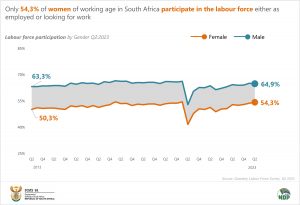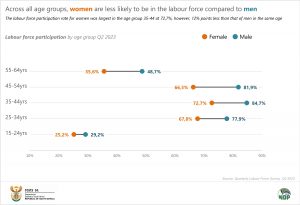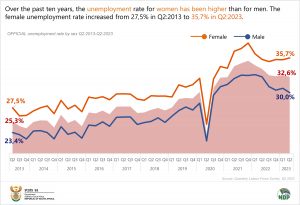South Africa celebrates Women’s Month in August. 9 August commemorates the women’s march of 1956, a protest against the extension of Pass Laws to women, which sought to control rather than empower them. The 2023 theme for Women’s Month, ‘Accelerating Socio-Economic Opportunities for Women’s Empowerment’, calls for the heightening of socio-economic programs and activities across different economic sectors to create more employment opportunities for women. However, the labour market in South Africa remains more favourable to men than women, revealing large gender gaps in employment.
This is not unique to South Africa. Globally, workplace disparities between men and women continue to exist. Labour-force participation rates amongst women remain lower than men and women are also less likely to find work than men.
Women and young people fare worse in labour markets globally, often bearing the brunt of inequalities in labour markets. According to the Quarterly Labour Force Survey for the second quarter of 2023, South Africa’s labour force participation rate increased to 59,6% in the second quarter of 2023 from 58,6% recorded in the second quarter of 2022, an increase of 1 percentage point year-on-year. The labour force participation rate for women stood at 54,3% compared with 64,9% for men, a gap of 10,6 percentage points. Only 54,3% of women of working age in South Africa participate in the labour force either as employed or looking for work. The female labour force participation rate has seen an increase over 10 years by 4 percentage points from 50,3% in Q2:2013 to 54,3% in Q2:2023. However, women remain less likely to participate in the labour force compared to men.

In Q2:2023 the labour force participation rate was highest among South Africans aged 35 to 44 years (78,8%); young people aged 15-24 had the lowest labour force participation rate at 27,2%. The labour force participation rate for women was largest in the age group 35-44 at 72,7%; this, however, is 12 percentage points less than that of men in the same age group. Across all age groups, women are less likely to be in the labour force compared to men. The largest labour force participation gap was in the age group 45-54 at 15,5 percentage points. Female labour force participation showed an increase in all age groups between Q2:2022 and Q2:2023.

At a global level, the unemployment rate for women remains higher than that of men; youth unemployment rates are much higher than adults; and young women’s unemployment rate tends to be higher than young men’s.
South Africa continues to grapple with persistently high levels of unemployment, with the burden of joblessness being carried by women and young people. The official unemployment rate in Q2:2023 was 32,6%, a decline of 0,3 of a percentage point from the 32,9% recorded in Q1:2023. Unemployment numbers for women remain higher than the national average, with 35,7% of South African women in the labour force currently without work and actively looking for work. This is an increase of 0,3 of a percentage point quarter-on-quarter, and 0,2 of a percentage point year-on-year. The burden of unemployment is more pronounced for women as the unemployment rate for men indicates a continued decline of 0,7 of a percentage point quarter-on-quarter, and 2,6 percentage points year-on-year. Black African women fare even worse with an unemployment rate of 39,8% in Q2:2023, which is higher than the national average and other population groups.

When women are employed, they are more likely to work in low-paying jobs in vulnerable conditions, and there is a slow improvement forecast for the future (ILO,2017). According to the ILO, ‘vulnerable employment is a combination of ‘own account work’ and ‘contributing family work’ or unpaid household member, both defined as employment statuses that are associated with ‘low levels of development and high levels of poverty’. More women than men work as unpaid household members and women are less likely to be employers. In Q2:2023, only 3,3% of women were employers compared to 7,5% of men.
Gender disparities in the labour market still exist and the light shown by these labour market estimates echoes the need to accelerate the enhancement of women’s overall participation in employment, access to more opportunities across economic sectors and addressing job gaps that go beyond unemployment. Work is the most effective economic empowerment strategy for women. Women’s labour market participation must consequently be increased. Improving gender equality has numerous positive effects on both individual persons and society as a whole.
*All credit for this article below goes to the initial authors and the link to the original article can be found here:
https://www.whoownswhom.co.za/how-south-african-women-are-breaking-the-glass-ceiling-in-business/




